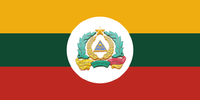National Democratic Alliance Army
| National Democratic Alliance Army | |
|---|---|
|
မြန်မာအမျိုးသား ဒီမိုကရက်တစ် မဟာမိတ်တပ်မတော် Participant in the Internal conflict in Myanmar | |
|
Flag of the National Democratic Alliance Army | |
| Active | 1989–2011 |
| Ideology | Shan nationalism |
| Leaders |
Sai Leun Sao Hsengla San Pae |
| Headquarters | Mong La, Myanmar |
| Area of operations | Mong La Township, Shan State |
| Strength | 3,000[1]–4,000[2] |
| Originated as |
|
| Allies |
|
| Opponents |
|
| Battles and wars | Internal conflict in Myanmar |
The National Democratic Alliance Army (Burmese: မြန်မာအမျိုးသား ဒီမိုကရက်တစ် မဟာမိတ်တပ်မတော်; abbreviated NDAA),[3] also known as the National Democratic Alliance Army-Eastern Shan State (NDAA-ESS), the Eastern Shan State Army)[4] and the Mongla Army, is an insurgent group in eastern Shan State, Myanmar (Burma). The latter name originated from its location in the Mong La Township in eastern Shan State, known also as 'Shan State Special region 4'.[5]
History
The Mongla area had been under the control of several warlords since the 1960s.[6] The NDAA was formed in 1989 after splitting from the former Communist Party of Burma (CPB). The strength of the army is 3,000 to 4,000 men.[2][1]
The NDAA was one of the first groups to sign a ceasefire with the Tatmadaw (Myanmar Armed Forces).[6] After the ceasefire, the area underwent an economic boom, with both the NDAA and local Tatmadaw units benefiting financially from increased opium harvests and narcotics trafficking.[7] The NDAA declared an opium ban in the Mongla region in 1997 and signed a new ceasefire with the Burmese government in 2011.[8]
The NDAA maintains close ties with other rebel armed groups that split from the CPB, such as the Myanmar Nationalities Democratic Alliance Army (MNDAA), the New Democratic Army - Kachin (NDA-K), and the United Wa State Army (UWSA). In 2008 the UWSA was strongly against giving away the area of Mong Pawk from its control because it serves as a link with its ally, the National Democratic Alliance Army in Mongla.[9]
See also
- Internal conflict in Burma
- List of political and military organisations in Burma
- United Wa State Army
References
- 1 2 "NDAA". Myanmar Peace Monitor. Retrieved 2016-02-28.
- 1 2 "Armed ethnic groups". Myanmar Peace Monitor. Retrieved 2016-01-29.
- ↑ NDAA and UWSA deny involvement in Mekong incident
- ↑ The National Democratic Alliance Army-Eastern Shan State
- ↑ Another wrong turn in Mong La
- 1 2 South, Ashley (2008). Ethnic politics in Burma: states of conflict. Taylor & Francis. p. 140. ISBN 978-0-203-89519-1.
- ↑ Skidmore, Monique; Wilson, Trevor (2007). Myanmar: the state, community and the environment. ANU E Press. p. 69.
- ↑ Neither War Nor Peace - Transnational Institute
- ↑ Wa leader: UWSA able to defend itself
External links
- Wa, Mongla rebels say Burmese army undermining peace process
- Tensions Rise in Wa Region
- Market Growth and Moral Decline in Mong La
- Dirty Old Town
